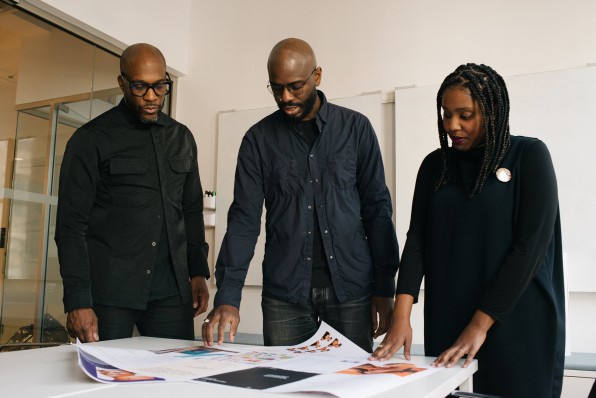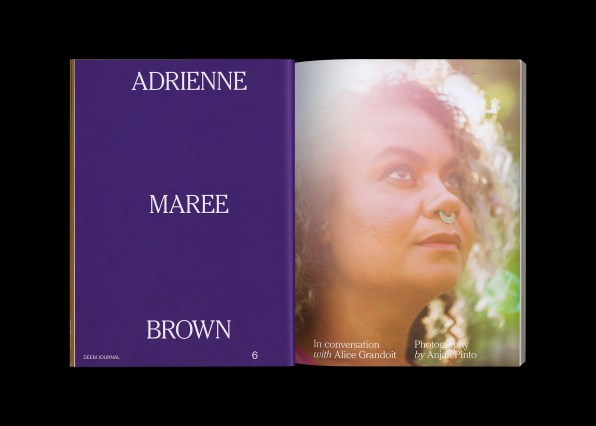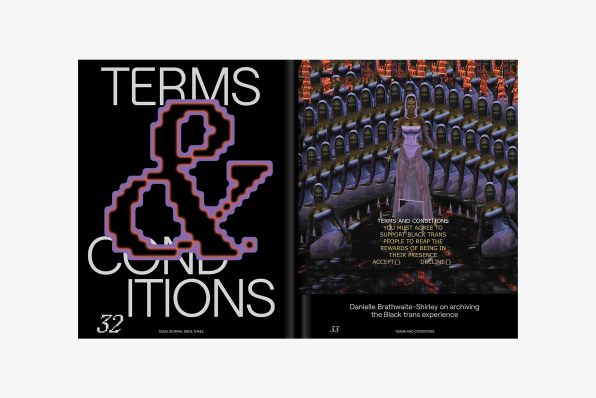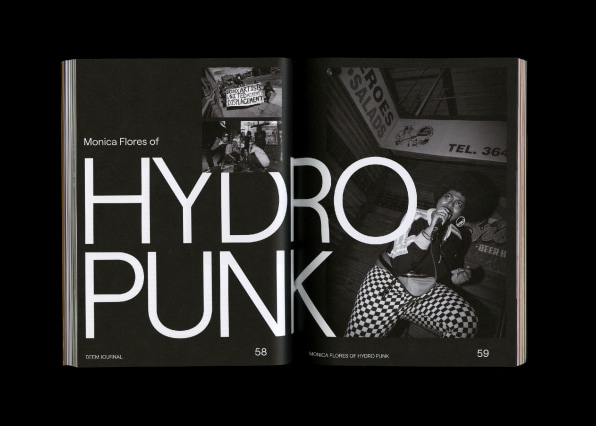- | 12:00 pm
A bold new design journal is upending the status quo: ‘Design should feel more like jazz’
The biannual publication has been pushing for a more equitable understanding of design for two years.

What is design? And who gets to decide what it means?
Since 2019, the founding trio behind Deem Journal has been pushing for a more equitable understanding of design. Rooted in the belief that design is everywhere, the biannual print publication and online platform has been exploring the role of design as a social practice that’s less preoccupied with aesthetics and more interested in the process.
Now, Nu Goteh, Alice Grandoit-Šutka, and Marquise Stillwell have been granted an award by the American Institute of Architects in New York. The New Perspectives Award celebrates individuals and collectives who take critical positions that help broaden our understanding of architecture; Deem Journal is the inaugural recipient.
I took this opportunity to join the founders on Zoom and discuss Deem’s evolution. We talked about the narrow definition of design and how it perpetuates inequity; how nontraditional designers can make design more inclusive; and how design should take more cues from jazz.
This interview has been lightly edited for clarity.

From left: Deem Journal founders Marquise Stillwell, Nu Goteh, and Alice Grandoit-Šutka [Photo: Courtesy Deem Journal]
Fast Company: What inspired you to start Deem Journal?Nu Goteh: Deem is a resolve of three different design practitioners coming together and trying to solve for a problem that we all saw in the world of design: that [it] was hyper-focused on specific things and very much excluded different perspectives.
Design often gets codified within objects and outputs, and the issue with that is we’ve been trained to look through the lens of fidelity—so how beautiful, finished, and polished is said design? But the trap there is that fidelity is restricted by resources, and resources aren’t evenly distributed. And so oftentimes what happens is that the people who get to be designers are the people who are resourced to be designers.
We actually call bullshit on that. There are many more opportunities to look at design beyond outputs. For us, design is a process of adding value, and that process isn’t exclusive to just designers. So we set out to start to open up more conversations and invite many more perspectives into the world of design.
So much focus today is on the look of an object, and this obsession with aesthetics is only made worse by Instagram. How do we bring back the idea that intention and process are just as important and valuable as the final output?
Goteh: For us, it’s really starting to look for inspiration outside of the practice and to look at different people who are participating in the process, whether they acknowledge it or not. So, it’s not necessarily going to the same well of designers—with a capital D—and asking them, “What’s your process?” It’s more looking at the process holistically and finding different practitioners who are in design, or are adjacent to design, who are facilitating and participating in the process of adding value.
Alice Grandoit-Šutka: A lot of that really comes from just demystifying design. A reason why a lot of the conversations tend to move toward the output is because it’s something tangible that people can see, and maybe they don’t have to overintellectualize it. A lot of what we’re trying to do with Deem is build evidence for people to see themselves within these processes, and to see that they actually do participate in them regularly, whether they believe it to be design or not.
On the cover of your very first issue, Designing for Dignity, you featured someone who isn’t a designer. What does the writer and activist Adrienne Maree Brown bring to the design conversation?
Marquise Stillwell: I guess I would counter that she is a designer. And I would say that’s the reason why we put her on there, because she does represent the challenge within design in the way that we actually call out who are designers and who are not.
Grandoit-Šutka: I think everybody who you will see on Deem, maybe in a larger context to traditional gatekeepers, they might not see these people as designers, but I think that’s exactly what we’re trying to do is open up the conversation. And Adrienne Maree Brown felt like a perfect person to highlight—a Black woman “design doer.”

[Photo: Courtesy Deem Journal]
What’s your definition of design?
Stillwell: I mean, what does it mean to be beautiful? It means that I see myself as beautiful. Does that mean that Vogue or Elle tells me what beautiful is? Well, they have, and they’ve [also] challenged that. It’s the same thing we’re doing with design, and I think that design has been held hostage by a few gatekeepers who continue to either over-theorize what design is, or overly add this essence of fidelity that says design looks like this.
Are you shying away from a more concrete definition because it doesn’t exist?
Stillwell: No, the concrete definition of beauty is how you see yourself. The concrete definition of design is the way you see yourself. Design is about adding value, but we create artificial speed bumps by not allowing individuals to deem themselves as part of the design world. And that’s the challenge when you look at these other gatekeepers or design firms who refuse to hire people who don’t fit in this very narrow definition. I wouldn’t even call it narrow. It is not a real definition.
In your first issue, you explored the idea that design is so pervasive we often fail to notice it. Is that necessarily a bad thing? Or maybe it’s a bad thing when it goes unnoticed intentionally?
Stillwell: I think that’s when design goes unnoticed in regards to the process. Life is not a microwave. For a lot of us, particularly in the design space, we believe that we can solve quick problems with these tools, and therefore we create shiny objects that don’t last and we don’t build in the social factors of what it means to be human.
To be human requires patience, and that requires a process that can be repeated, but added on to, similar to the way that we listen to jazz. Jazz has these initial standards, but the beauty of jazz is that it improvises and continues to add value for each note and each sound. In many ways, design should feel more like jazz as a social practice—coming together to add value together.

[Photo: Courtesy Deem Journal]
Your most recent issue, Envisioning Equity, talks about equity as a design challenge. How can design address this?Grandoit-Šutka: In this context, I think design can at least help us acknowledge that the distribution of ownership within our current social system didn’t occur naturally. It is actually a product of design. And if things were designed to perpetuate inequality, then how do we use design to reconfigure that concept of equity, and even challenge if it’s something that could help repair the harm that has been made?
In the third issue, you have a section called Partner Pages where you highlight organizations, businesses, and initiatives that model how design can add value to communities, and you note that these placements are not paid. Why did you choose to highlight these organizations in that way?
Stillwell: We’re not going to have paid partners that are just advertising a widget. If we work with a partner, we really want the partner to highlight how it’s doing the work versus, again, the fidelity of the work. So, Herman Miller just putting a chair in for us isn’t the type of communication that we like to express. It’s more about highlighting the people and the process for how that chair manifested itself.

[Photo: Courtesy Deem Journal]
What’s your ultimate hope for Deem, and where do you envision it going next?Grandoit-Šutka: I would love to see Deem continue to become resourceful in terms of supporting communities of practice, and really pushing for a lot of this wider representation. And I think most specifically trying to maybe remap—I don’t really like to use this word, but it is a word that we use—a new canon for design. I’ve been thinking about it more as constellations, [and] maybe something that is pluralistic.
Goteh: For us, design doesn’t just live between pieces of paper or on a screen; it’s a lived experience that we all share every day. So our goal is to really start to expand our philosophy beyond print to different types of experiences, whether they’re IRL, with us convening together, or even trying to find ways of leveraging other mediums. And we’re going to continue pushing that, bringing in many different perspectives as well.




































